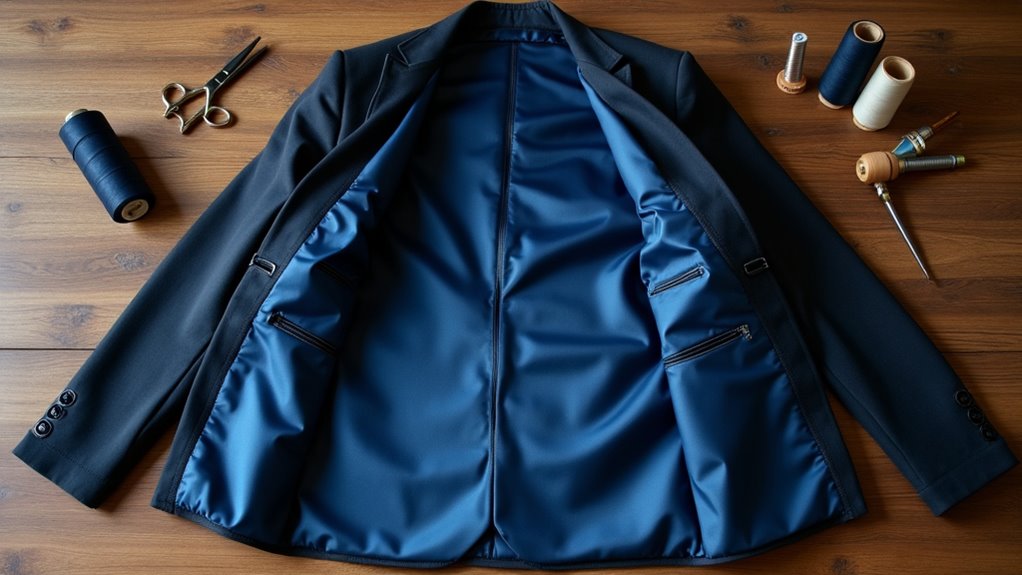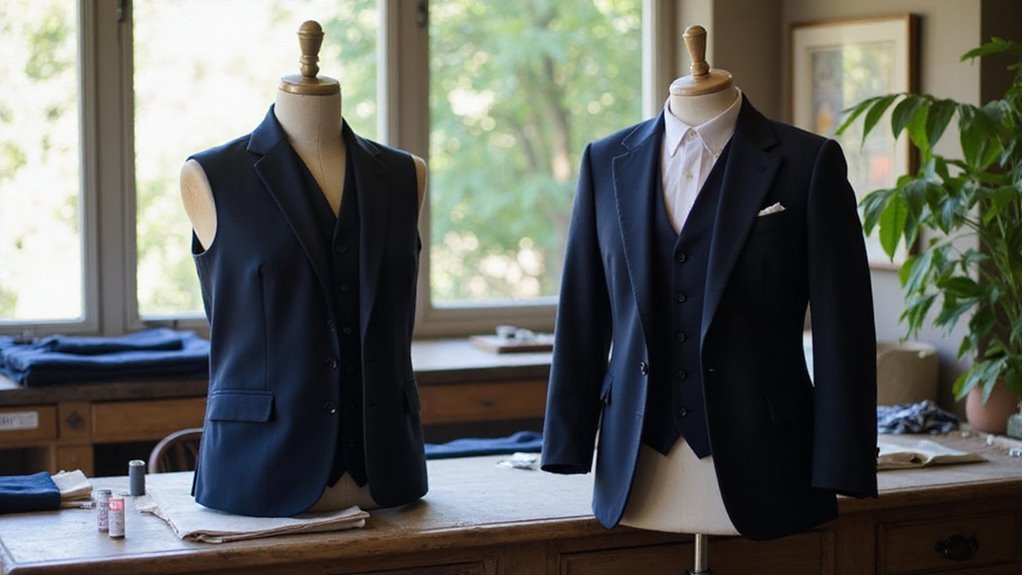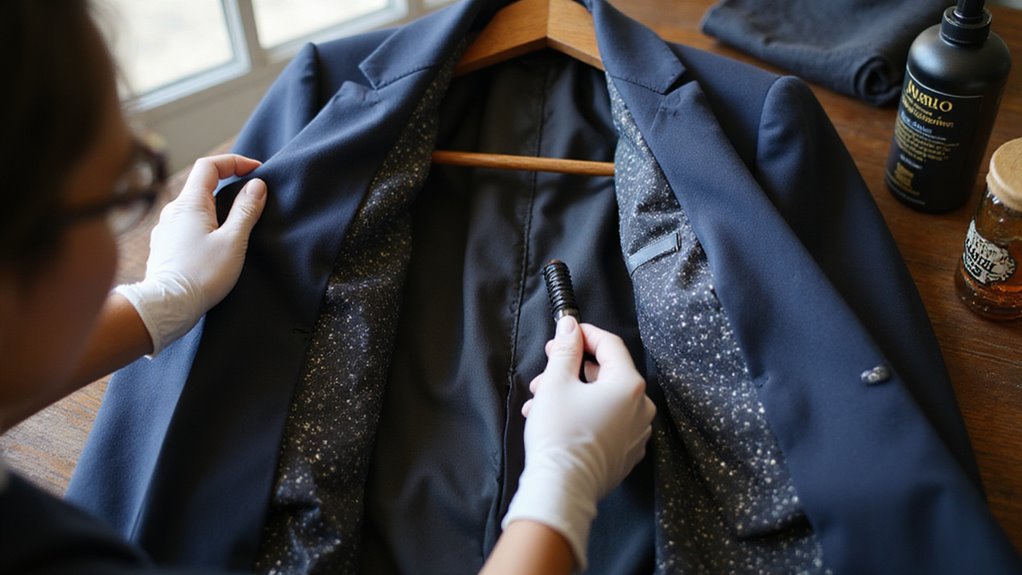Choosing the right suit lining can be confusing. Most people overlook it, focusing only on the outer fabric. However, the lining affects comfort, structure, and even how long your suit lasts. If you pick the wrong one, you could end up sweating, feeling stiff, or wearing out your jacket too soon.
Many shoppers regret their suit choices. They may feel uncomfortable during long meetings or notice their jacket doesn’t fit well after a few months. Some linings can make you hot, while others tear easily or make the suit lose its shape. The wrong lining can ruin an otherwise perfect suit.
Luckily, you can avoid these problems by understanding suit linings and picking the best option for your needs. Everything you need to know about suit linings is right here—so you can make the right choice every time. This blog will guide you through the best lining materials and styles for any situation.
Key Takeaways
- Suit linings are inner fabric layers that enhance comfort, structure, and durability while covering seams for a polished interior appearance.
- Common lining materials include viscose, polyester, cupro, silk, and acetate, each affecting breathability, comfort, and suit weight.
- Lining types range from fully lined (structured, warm) to unlined (lightweight, breathable), influencing suitability for different seasons and climates.
- Linings offer customization with colors, patterns, and personalized details, allowing for both classic and bold style choices.
- Regular inspection, proper cleaning, and timely repairs of linings are essential for suit longevity and maintaining comfort and appearance.
What Is a Suit Lining?

A suit lining is a layer of fabric inside a suit jacket. It covers seams and helps the jacket keep its shape. The lining also makes the jacket more comfortable to wear. If a jacket has a lining, it will feel smoother and look neater inside. Early suit linings used cotton or rough silk. Over the years, manufacturers developed softer and more durable fabrics. Today, linings can have bright colors or patterns. Some linings use special weaves for better comfort and airflow.
Many modern designers now use digital suit mockup PSD templates to efficiently visualize and customize lining designs before manufacturing. Knowing about linings helps you understand how suits are made and why they feel good to wear. Modern suit makers often use advanced rendering techniques when designing linings, allowing for more creative and sustainable choices before physical production begins.
Common Materials Used for Linings
The lining material affects a suit jacket’s comfort, look, and life span. Viscose comes from wood pulp and feels smooth. If you want breathability, viscose is a good choice, but it may not be eco-friendly. Polyester is a strong and low-cost synthetic, but it traps heat and has environmental downsides. Cupro is made from cotton waste, feels like silk, and resists static. If you want a natural feel, cupro is an option, though its making uses chemicals.
Silk is a luxury material that regulates temperature well, but it can raise ethical and resource concerns. Acetate is glossy and light, but it is less strong and can get damaged by moisture. Many designers use high-resolution images of linings in their mockups to help clients better visualize how a finished suit will look. When choosing a lining, some designers use mockups and fabric samples to help clients visualize and select the best materials for their needs.
Pros and Cons of Fully Lined Suits

Many tailors recommend fully lined suits because they give structure and a polished look. A full lining helps the jacket keep its shape. The lining covers inside seams, making the jacket neater and more durable. Movement is smoother because the fabric glides easily. Some linings use modern materials that wick moisture and prevent static. Similar to how moisture-wicking materials are valued in activewear, these advanced linings can improve comfort during extended wear.
Using standardized mockup templates can also help visualize how different linings and fabrics will look in a finished suit before making a final decision. There are some drawbacks. Fully lined suits can feel hot and are less breathable. These suits are not ideal for warm weather. The extra fabric makes the jacket heavier and can limit movement. Cleaning and altering a fully lined suit is also more difficult. If you want structure and a classic look, a fully lined suit is a good choice.
Understanding Half-Lined and Quarter-Lined Jackets
Half-lined and quarter-lined jackets are lighter than fully lined suits. Half-lined jackets have lining in the upper back, shoulders, and sleeves only. The lower back and sides stay unlined, so you get more breathability. Quarter-lined jackets have even less lining, usually just in the shoulder area. This design gives you maximum airflow while keeping necessary support. These jackets show off careful craftsmanship since the inside seams are visible.
If you want, you can pick unique colors, patterns, or materials for the lining. Half- and quarter-lined jackets work well if you need better ventilation and a neat look. They also let you add a personal touch to your wardrobe. For those interested in custom tailoring, mockup PSD files let you preview different lining options and visualize how your design choices will look before the suit is made. Incorporating visual storytelling into your mockup presentations helps clients clearly understand the potential of their custom jacket.
Unlined Suits: When and Why to Choose Them

Unlined suits are best when you need maximum breathability and lightness. They are ideal for hot weather, resorts, or tropical climates. If you want a cool and comfortable suit, choose an unlined option.
This style has no inner lining, so fabric choice is important. Tightly woven linen, cotton, or lightweight wool works best. When choosing an unlined suit, consider that seam finishing is crucial since the inside will be visible and should look polished. All seams should be neatly finished, since they are visible inside.
Unlined suits have less structure and offer a relaxed shape. These suits are also lighter, which helps if you travel or have long days. If you prefer easy movement and a natural feel, consider an unlined suit. Many modern designers take inspiration from the evolution of suit tailoring, using unlined suits to create a contemporary, comfortable silhouette.
How Lining Affects Comfort and Breathability
Lining impacts how comfortable and breathable your suit feels. It acts as a barrier between your body and the suit fabric. If the lining is thick or synthetic, it can trap heat and sweat. A natural fiber lining, like silk or cupro, allows air to flow and moves moisture away from your skin. Full linings keep you warmer but reduce ventilation. If you choose a half or quarter lining, you will get better airflow.
Some linings have special finishes to move sweat away and help you stay dry. In high-end tailoring, the quality perception of a suit is often elevated by thoughtful lining choices that enhance both comfort and durability. If you want more comfort, pick a lining that is light and lets your skin breathe. Choosing the right lining is as important as measuring your chest and waist to ensure your suit fits and feels great.
The Role of Lining in Suit Structure and Shape

The lining gives a suit its structure and helps it keep its shape. It supports the fabric and stops it from sagging. If the lining is strong, the suit will not lose its form over time. Tailors have always used different linings to make suits last longer. Modern linings use special fibers to add strength and keep the suit looking sharp. The lining also connects with parts like canvassing and shoulder pads.
This helps the suit drape well and keeps its shape. Just as designers use layered mockup templates to preview their work with precision, the structure provided by a quality lining ensures that the suit maintains its intended form and aesthetic. Whether you choose a custom or bespoke process, the quality of the lining can significantly influence both the longevity and the overall presentation of your suit.
| Lining Function | Structural Impact |
|---|---|
| Reinforcement | Keeps jacket in shape |
| Prevents stretching | Stops fabric distortion |
| Supports tailoring | Makes silhouette sharp |
If you choose the right lining, your suit will look better and last longer.
Popular Colors and Patterns for Linings
When you select a suit lining, you’ll notice classic color options like navy, silver, and black offer timeless versatility. Bold patterned linings—think paisley, stripes, or geometric motifs—let you introduce personal flair without compromising exterior formality.
You can also track seasonal trends, which often feature lighter hues or dynamic prints for spring and summer collections. For those designing custom suit visuals, you can save time and achieve a polished look by using high-quality PSD templates specifically tailored for mockups and pattern presentations.
Classic Lining Color Choices
Classic suit linings use colors like navy, burgundy, silver gray, and black. These shades are chosen for their timeless look and easy coordination. They match most suit fabrics and keep the inside look simple and sharp.
Deep navy shows confidence and fits blue, gray, or charcoal suits. Burgundy gives warmth and works well with navy or brown fabrics. Silver gray is a neutral choice, which matches both light and dark suits.
Bold Patterned Linings
Bold patterned linings make your suit stand out and show your personal style. These linings often use paisley, geometric, or floral patterns. Popular colors include blue, burgundy, green, and metallic shades. Jacquard weaves or digital prints give the lining a sharp and durable look. If you want a strong effect, choose a full bold pattern. A half or butterfly lining gives a more subtle accent. Your choice of lining can add confidence and individuality to your suit.
Seasonal Lining Trends
Suit linings change with the seasons to match current colors and patterns. Spring and summer use light fabrics and soft colors for comfort. Autumn and winter use darker, heavier linings for warmth. New lining techniques now allow bright prints and strong fabrics. Always choose a lining that looks good and fits the season.
- Spring/Summer: Pick silk or Bemberg linings in light blue, mint, or floral prints for coolness and a fresh look.
- Autumn: Select deeper burgundy, forest green, or geometric patterns to add warmth and style.
- Winter: Use heavier viscose or cupro linings in charcoal or navy with subtle designs for extra warmth and comfort.
Custom and Personalized Lining Options
Custom and personalized suit linings let you create a unique jacket interior. You can pick from silk, bemberg, or viscose fabrics. Each fabric offers different textures and colors. You may choose patterns that match your style. Custom embroidery lets you add designs or small motifs inside your jacket.
Personalized monograms can be stitched into the lining. If you want, you can select the thread color, font, and location for these details. These options turn your suit lining into a way to show your personality. Advanced textile methods help combine tradition with modern style.
Caring for and Maintaining Suit Linings

You need to use proper cleaning techniques to preserve your suit lining’s structure and sheen. Always spot clean stains promptly and rely on professional dry cleaning to prevent fabric distortion. To minimize wear and tear, rotate your suits and use wide-shouldered hangers for storage.
Proper Cleaning Techniques
Suit linings need gentle cleaning to protect their delicate fabrics. You should not wash a suit in a machine. Hand cleaning is best for most situations. If you clean the lining wrong, it can cause damage or expensive repairs.
- Use a damp, soft cloth to dab small stains right away.
- Take your suit to a dry cleaner if you cannot remove stains at home.
- Hang your suit in fresh air after each use to remove odors.
Preventing Wear and Tear
Daily habits help prevent suit lining damage. Use wide, shaped hangers to keep the lining in good shape. Never overfill jacket pockets, as this can strain the seams. Rotate your suits to avoid wearing out the lining too quickly. Sharp items or rough surfaces can easily snag the lining, so handle suits with care. Silk and Bemberg linings have a long history of strength and comfort. Store suits in breathable bags if you want to avoid moisture and protect the lining. Always let suits air out after wearing to keep the lining fresh.
How Lining Impacts Suit Weight and Seasonality
Suit lining affects how heavy a suit feels and when you should wear it. Linings add an extra layer between the fabric and your skin. This layer can make a suit warmer or cooler, depending on the material. If you choose a technical or moisture-wicking lining, the suit stays lighter and keeps you drier. These linings are helpful for hot weather or active use.
- Full Linings: These add warmth and structure, making them best for cold weather. They can feel too hot in the summer.
- Half or Quarter Linings: These are lighter and more breathable, working well in spring and summer.
- Unlined Suits: These offer the most airflow and the least weight. They depend on quality fabric to keep the jacket’s shape.
Pick the lining type based on the weather and how much comfort you want.
Differences Between Off-the-Rack and Bespoke Linings
Off-the-rack and bespoke suit linings are not the same. Off-the-rack linings use standard materials like polyester or acetate. These linings are made in bulk and sewn by machines. If you buy one, you get limited choices in color and pattern.
Bespoke suit linings allow you to choose from fine materials like silk or cupro. A tailor installs these linings by hand for a smooth fit. You can request special touches, such as custom designs or hand-sewn seams. If you want more personalization, a bespoke lining is the better choice.
Choosing the Right Lining for Your Needs
When selecting a suit lining, you’ll weigh breathability and comfort against durability and maintenance requirements. Materials like Bemberg and silk offer superior airflow, while synthetics such as polyester provide increased abrasion resistance. Consider how often you’ll wear the suit and the climate, as these factors impact the optimal balance between comfort and longevity.
Breathability and Comfort Factors
Suit lining affects both comfort and airflow. You should choose a lining that helps your skin breathe and feels soft. Good linings also keep your body temperature comfortable in different weather.
- Bemberg Rayon and Silk: These materials wick moisture and allow air to pass, making them good for warm weather.
- Polyester and Acetate: These linings are affordable but can trap heat and may feel less comfortable when it is hot.
- Partial or Unlined Construction: Jackets with less lining let more air in. These work well if you need extra ventilation.
If you want a comfortable suit, choose your lining materials carefully.
Durability and Maintenance Tips
Durability and maintenance are important for your suit lining. Choose a fabric with strong abrasion resistance if you wear suits often. Cupro and Bemberg linings last longer than silk, which wears out faster. Viscose blends and technical synthetics help keep the lining strong and protect against sweat and friction.
Brush the inside of your jacket regularly and clean stains right away. Never use a washing machine to clean the lining. If you add reinforced seams or double layers, the lining will last longer in busy areas. Consider these steps to keep your suit looking good and working well.
Signs It’s Time to Replace or Repair Your Lining
If your suit lining shows damage, it may be time to repair or replace it. The lining can wear out even if the suit looks fine on the outside. Suit linings were designed for both comfort and strength, but they still break down over time.
Fraying or tearing at the seams is a clear sign. Discoloration or stains that won’t wash out mean the fabric is wearing out. Sagging or bunching shows the lining has lost its shape. If you notice these problems, consider fixing the lining soon. This helps your suit stay comfortable and last longer.
Conclusion
If you want your suit to last, you should pay attention to its lining. The right material, such as cupro or silk, can improve comfort and durability. If you choose a full, partial, or unlined suit, you can match your needs and the season.
If you inspect and care for your suit lining, your suit will keep its shape and look sharp. The lining also lets you add a touch of personality with colors or patterns. If you make wise choices, your suit will always stand out in any setting.
If you are ready to elevate your suit, you should try a Custom Mockup to see your options. A custom lining can set your suit apart from the rest. Take the next step and design your ideal suit lining today.



No Comment! Be the first one.